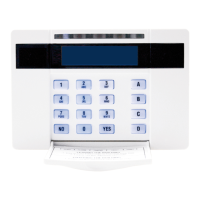
Do you have a question about the Pyronix Castle EURO 46 Series and is the answer not in the manual?
| Brand | Pyronix |
|---|---|
| Model | Castle EURO 46 Series |
| Category | Control Panel |
| Language | English |
Steps to access the Engineer Menu by entering the default code and confirming prompts.
Procedure to exit the Engineer Menu by selecting 'EXIT ENGINEERS MENU'.
Highlights key Engineer Menu functions with their respective page numbers for quick reference.
General overview and specifications of EURO control panels, detailing maximum inputs and features.
Details the mapping of wired inputs for different EURO panel models (46, 162, 280).
Details the mapping of wireless inputs for different EURO panel models.
Lists the default Engineer, Master Manager, and User codes for system access.
Describes the sequence of events and display messages during initial panel power up.
Procedure to test keypad functionality by activating all LEDs and scrolling the display.
Information on connecting and addressing additional keypads and readers to the control panel.
Guide on programming text for input names and system messages using predictive text.
Information on setting Grade 2 or Grade 3 defaults via the 'CLEAN START' function.
Steps for setting and unsetting the system using the Engineer code.
Function to force arm the system using two nominated inputs for testing or specific scenarios.
Controls the panel's response to Fire and Hold Up alarms when in Engineer Menu.
Displays the software version number, serial number, and product information.
Selects End of Line resistor values for inputs and Zone Expander Modules.
Process for addressing and installing Zone Expander Modules (ZEMs) onto the control panel.
Manages the learning and deletion of wireless inputs and bells from the system.
Programs input types, attributes, areas, and names for system inputs.
Addresses and configures keypads and readers, including their types and set points.
Programs keypad text, site name, and display options for system status messages.
Configures various system timers such as Entry, Exit, and Siren times.
Sets the system's date, time, and enables or disables Daylight Saving Time adjustment.
Defines how the system sets upon exit, including Timed, Final Door, and Push to Set modes.
Manages Engineer, Master Manager, Duress, and Guard codes, and PIN settings.
Adjusts volume levels for different system sounds like Entry, Exit, and Alarm.
Controls how the system responds to alarms, including silent alarms and confirmation settings.
Programs output types and configurations for endstation, ZEM, and module outputs.
Enables automatic setting of areas based on specific conditions and user assignments.
Configures various system-wide operational options to tailor panel behaviour.
Sets engineer-only reset requirements for specific alarm types and faults.
Accesses and reviews system event logs and access control logs for auditing.
Performs tests on inputs, outputs, batteries, and siren to verify system functionality.
Shows system readings like power supplies, input status, and wireless device status.
Configures the system for uploading and downloading software and programming.
Configures Alarm Receiving Centre (ARC) and SMS signalling formats and numbers.
Allows the panel to dial out to a remote PC for various operations like testing or data transfer.
Resets the system to factory defaults, clearing data like codes, logs, and wireless devices.
Lists default settings for various Engineer Menu options for Grade 3 and Grade 2.
Lists and describes various input types and their operational characteristics.
Details of all programmable timers and their operational ranges for the system.
Lists and describes all available output types and their active/restore functions.
Lists content type numbers and their corresponding descriptions for SMS messaging.
Lists fault types, their descriptions, and recommended solutions for troubleshooting.
